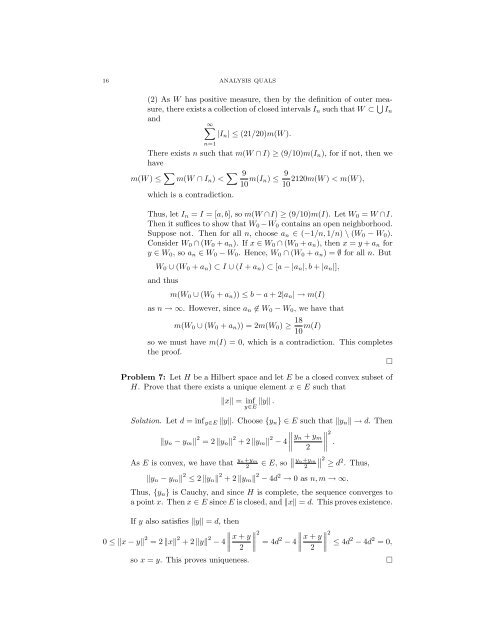ANALYSIS QUALIFYING EXAM PROBLEMS BRIAN LEARY ...
ANALYSIS QUALIFYING EXAM PROBLEMS BRIAN LEARY ...
ANALYSIS QUALIFYING EXAM PROBLEMS BRIAN LEARY ...
Create successful ePaper yourself
Turn your PDF publications into a flip-book with our unique Google optimized e-Paper software.
16 <strong>ANALYSIS</strong> QUALS<br />
(2) As W has positive measure, then by the definition of outer measure,<br />
there exists a collection of closed intervals In such that W ⊂ In<br />
and<br />
∞<br />
|In| ≤ (21/20)m(W ).<br />
n=1<br />
There exists n such that m(W ∩ I) ≥ (9/10)m(In), for if not, then we<br />
have<br />
m(W ) ≤ m(W ∩ In) < 9<br />
10 m(In) ≤ 9<br />
2120m(W ) < m(W ),<br />
10<br />
which is a contradiction.<br />
Thus, let In = I = [a, b], so m(W ∩I) ≥ (9/10)m(I). Let W0 = W ∩I.<br />
Then it suffices to show that W0 −W0 contains an open neighborhood.<br />
Suppose not. Then for all n, choose an ∈ (−1/n, 1/n) \ (W0 − W0).<br />
Consider W0 ∩ (W0 + an). If x ∈ W0 ∩ (W0 + an), then x = y + an for<br />
y ∈ W0, so an ∈ W0 − W0. Hence, W0 ∩ (W0 + an) = ∅ for all n. But<br />
W0 ∪ (W0 + an) ⊂ I ∪ (I + an) ⊂ [a − |an|, b + |an|],<br />
and thus<br />
m(W0 ∪ (W0 + an)) ≤ b − a + 2|an| → m(I)<br />
as n → ∞. However, since an ∈ W0 − W0, we have that<br />
m(W0 ∪ (W0 + an)) = 2m(W0) ≥ 18<br />
10 m(I)<br />
so we must have m(I) = 0, which is a contradiction. This completes<br />
the proof.<br />
<br />
Problem 7: Let H be a Hilbert space and let E be a closed convex subset of<br />
H. Prove that there exists a unique element x ∈ E such that<br />
x = inf y .<br />
y∈E<br />
Solution. Let d = infy∈E y. Choose {yn} ∈ E such that yn → d. Then<br />
yn − ym 2 = 2 yn 2 + 2 ym 2 2<br />
yn<br />
− 4 <br />
+ ym <br />
<br />
2 .<br />
As E is convex, we have that yn+ym<br />
2 ∈ E, so yn+ym<br />
<br />
<br />
2<br />
2 ≥ d2 . Thus,<br />
yn − ym 2 ≤ 2 yn 2 + 2 ym 2 − 4d 2 → 0 as n, m → ∞.<br />
Thus, {yn} is Cauchy, and since H is complete, the sequence converges to<br />
a point x. Then x ∈ E since E is closed, and x = d. This proves existence.<br />
If y also satisfies y = d, then<br />
2<br />
<br />
<br />
x + y <br />
<br />
2 = 4d 2 <br />
<br />
− 4 <br />
x + y <br />
<br />
2 <br />
0 ≤ x − y 2 = 2 x 2 + 2 y 2 − 4<br />
2<br />
≤ 4d 2 − 4d 2 = 0,<br />
so x = y. This proves uniqueness.
















